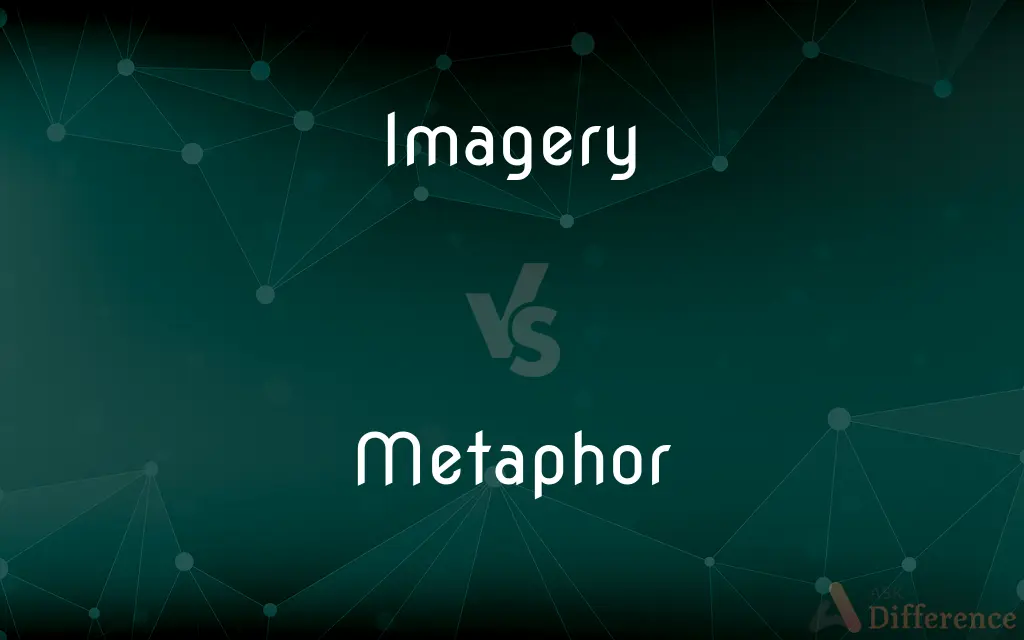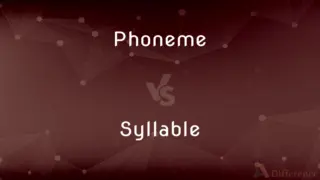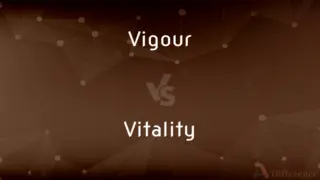Imagery vs. Metaphor — What's the Difference?
Edited by Tayyaba Rehman — By Fiza Rafique — Updated on November 3, 2023
Imagery invokes the five senses to paint a picture in the reader's mind, while a metaphor directly compares two things without using "like" or "as."

Difference Between Imagery and Metaphor
Table of Contents
ADVERTISEMENT
Key Differences
Imagery is a literary device used to create visual representation in the mind of the reader, often through descriptive language that appeals to the senses. Metaphor, by contrast, is a figure of speech that implies a comparison between two unlike things, suggesting they are alike in a significant way. While imagery relies on concrete descriptions, metaphors are abstract, conveying complex concepts through simplicity and symbolism.
Imagery can engage any of the five senses—sight, sound, smell, touch, and taste—to evoke a mood or setting. Metaphors, though, primarily work on an intellectual level, allowing readers to uncover deeper meanings behind the literal text. Through imagery, a writer might vividly describe the crimson hue and velvety texture of rose petals. A metaphor, however, might declare that "the garden was a velvet box," without mentioning roses directly.
The use of imagery can be broad and varied, painting detailed pictures of landscapes, sounds of cities, or flavors of a meal. A metaphor is a pointed comparison, such as saying "time is a thief" to imply that it steals moments from our lives. While imagery builds the world in which the story takes place, metaphors provide insight into the narrative's underlying themes and characters' emotions.
In creating imagery, authors often use a collection of adjectives and adverbs, inviting readers to experience the story’s environment as if they were there. Metaphors, in their brevity, might use none of these, instead connecting disparate ideas with the simplicity of a phrase like "the world's a stage." Imagery furnishes the scenery upon the stage of the reader’s mind, while a metaphor hints at the play being acted out.
Imagery and metaphor can sometimes intersect when a writer uses descriptive language to draw a metaphorical comparison. However, while imagery aims for clarity and sensory experience, metaphor strives for concise, figurative resonance. For instance, describing a character's voice as "a warm breeze on a summer's day" employs both imagery and metaphor to not only describe a voice but also evoke feelings of comfort and ease.
ADVERTISEMENT
Comparison Chart
Definition
Use of descriptive language to create sensory experience.
A figure of speech comparing two unlike things directly.
Purpose
To paint a picture and evoke sensory reactions.
To convey a new understanding through indirect comparison.
Language Used
Descriptive, often using adjectives and adverbs.
Concise, using implied comparison without descriptive terms.
Sensory Appeal
Appeals to one or more of the five senses.
Primarily intellectual appeal.
Example
"The icy wind bit at my cheeks."
"The wind was a shark, unseen yet biting."
Compare with Definitions
Imagery
A literary tool that evokes a visual representation or sensation in the audience.
The chocolate, rich and velvety, melted on her tongue.
Metaphor
A figure of speech that implies a comparison between two unrelated things.
His thoughts were a tangled web of confusion.
Imagery
Words or phrases that create a vivid sensory experience for the reader.
The leaves rustled like crumpled paper in the wind.
Metaphor
Language that denotes one thing in terms of another, suggesting a likeness.
Her eyes were windows to her soul.
Imagery
Language that appeals to the senses and paints a picture in the reader's mind.
The scent of lavender wafted through the room, soothing and sweet.
Metaphor
A literary figure of speech where a word or phrase is applied to an object or action to which it is not literally applicable.
Time is a thief that steals our moments.
Imagery
Part of the figurative language in a literary work, whereby the author uses vivid images to describe a phenomenon
Metaphor
An implied analogy used to convey an idea or attribute.
The classroom was a zoo this morning.
Imagery
Visually descriptive or figurative language, especially in a literary work
Tennyson uses imagery to create a lyrical emotion
Metaphor
A rhetorical device that symbolizes one thing as being the same as another.
Hope is a beacon in the night.
Imagery
Visual images collectively
The impact of computer-generated imagery on contemporary art
Metaphor
A metaphor is a figure of speech that, for rhetorical effect, directly refers to one thing by mentioning another. It may provide (or obscure) clarity or identify hidden similarities between two different ideas.
Imagery
A set of mental pictures or images.
Metaphor
A figure of speech in which a word or phrase is applied to an object or action to which it is not literally applicable
Her poetry depends on suggestion and metaphor
When we speak of gene maps and gene mapping, we use a cartographic metaphor
Imagery
The use of vivid or figurative language to represent objects, actions, or ideas.
Metaphor
A figure of speech in which a word or phrase that ordinarily designates one thing is used to designate another, thus making an implicit comparison, as in "a sea of troubles" or "All the world's a stage" (Shakespeare).
Imagery
The use of expressive or evocative images in art, literature, or music.
Metaphor
One thing conceived as representing another; a symbol
"Hollywood has always been an irresistible, prefabricated metaphor for the crass, the materialistic, the shallow, and the craven" (Neal Gabler).
Imagery
A group or body of related images, as in a painting or poem.
Metaphor
The use of a word or phrase to refer to something other than its literal meaning, invoking an implicit similarity between the thing described and what is denoted by the word or phrase.
Imagery
Representative images, particularly statues or icons.
Metaphor
A word or phrase used in such implied comparison.
Imagery
The art of making such images.
Metaphor
The use of an everyday object or concept to represent an underlying facet of the computer and thus aid users in performing tasks.
Desktop metaphor; wastebasket metaphor
Imagery
(Psychology) A technique in behavior therapy in which the patient uses pleasant fantasies to relax and counteract anxiety.
Metaphor
(intransitive) To use a metaphor.
Imagery
The work of one who makes images or visible representation of objects.
Metaphor
(transitive) To describe by means of a metaphor.
Imagery
Imitation work.
Metaphor
The transference of the relation between one set of objects to another set for the purpose of brief explanation; a compressed simile; e. g., the ship plows the sea.
Imagery
Images in general, or en masse.
Metaphor
A figure of speech in which an expression is used to refer to something that it does not literally denote in order to suggest a similarity
Imagery
(figuratively) Unreal show; imitation; appearance.
Imagery
The work of the imagination or fancy; false ideas; imaginary phantasms.
Imagery
Rhetorical decoration in writing or speaking; vivid descriptions presenting or suggesting images of sensible objects; figures in discourse.
Imagery
The work of one who makes images or visible representation of objects; imitation work; images in general, or in mass.
In those oratories might you seeRich carvings, portraitures, and imagery.
Imagery
Fig.: Unreal show; imitation; appearance.
What can thy imagery of sorrow mean?
Imagery
The work of the imagination or fancy; false ideas; imaginary phantasms.
The imagery of a melancholic fancy.
Imagery
Rhetorical decoration in writing or speaking; vivid descriptions presenting or suggesting images of sensible objects; figures in discourse.
I wish there may be in this poem any instance of good imagery.
Imagery
The ability to form mental images of things or events;
He could still hear her in his imagination
Imagery
Descriptive language that creates an image of the scene being described.
The sound of the rain against the window was a gentle drumbeat.
Common Curiosities
Is imagery only visual?
No, it can involve all five senses.
Can imagery and metaphor be used together?
Yes, writers often combine them to enhance the descriptive and symbolic quality of text.
What is the primary purpose of imagery?
Imagery aims to create a vivid sensory experience for the reader.
Does a metaphor always use the words "like" or "as"?
No, that would be a simile. Metaphors do not use "like" or "as."
What does a metaphor do?
A metaphor makes a symbolic comparison, suggesting that one thing is another.
What's the difference between a metaphor and a simile?
A simile makes a comparison with "like" or "as"; a metaphor does not.
What makes effective imagery?
Detailed, sensory-rich language that evokes clear images or sensations.
Is imagery only used in creative writing?
No, it's also used in non-fiction to engage readers.
Are metaphors meant to be taken literally?
No, metaphors are figurative and not meant to be literal.
Can a metaphor become a cliché?
Yes, when overused, a metaphor can become a cliché and lose its impact.
Can imagery be found in all genres of writing?
Yes, imagery is a common tool across all literary forms.
Are metaphors only used in poetry?
No, metaphors are used in all types of writing, from prose to daily speech.
Can imagery affect the mood of a story?
Absolutely, imagery can greatly influence the atmosphere and mood.
Why use a metaphor instead of a direct statement?
Metaphors can convey complex ideas succinctly and poetically.
Can metaphors be culturally specific?
Yes, metaphors can draw on cultural references that might not be universal.
Share Your Discovery

Previous Comparison
Phoneme vs. Syllable
Next Comparison
Vigour vs. VitalityAuthor Spotlight
Written by
Fiza RafiqueFiza Rafique is a skilled content writer at AskDifference.com, where she meticulously refines and enhances written pieces. Drawing from her vast editorial expertise, Fiza ensures clarity, accuracy, and precision in every article. Passionate about language, she continually seeks to elevate the quality of content for readers worldwide.
Edited by
Tayyaba RehmanTayyaba Rehman is a distinguished writer, currently serving as a primary contributor to askdifference.com. As a researcher in semantics and etymology, Tayyaba's passion for the complexity of languages and their distinctions has found a perfect home on the platform. Tayyaba delves into the intricacies of language, distinguishing between commonly confused words and phrases, thereby providing clarity for readers worldwide.














































